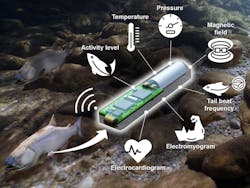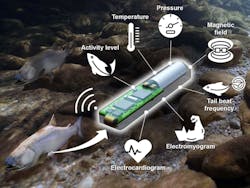A new fitness tracker for fish developed at the Pacific Northwest National Laboratory (PNNL) will soon be recording, storing and transmitting a trove of new information about fish health and behavior. The sensor, dubbed a Fitbit for fish or a Lab-on-a-Fish, gives those interested in conservation and aquaculture a cost-effective way to monitor fish in real time.
The sensor simultaneously collects data about a fish, including its location, heartbeat, tail movement and burned calories, as well as the temperature, pressure and magnetic field of its surrounding environment.
Historically, fish tags have been limited in the number of sensors that can fit on a small device without affecting the fish’s behavior or how long the device will operate. The new sensor weighs 2.4 grams, is about the size of a pen cap, and will collect and transmit data for up to eight months. This will let researchers study fish (even small ones) for a longer time than previously possible.
The sensor is surgically inserted under skin near a fish’s rear dorsal fins. As the fish swims, a wireless receiver picks up the sensor’s telltale beeps. Scientists can retrieve the data from a wireless receiver or the device itself.
The PNNL team was inspired to develop the Lab-on-a-Fish to help tackle a common challenge for hydropower projects, giving fish a way to safely navigate past dams. By law, some hydropower facilities must assure that migratory fish, such as salmon, can bypass dams and make it to the rivers where they reproduce. Their new senor lets scientists monitor fish passage success and determine if the fish encountered any physical stressors at specific points along their journey.
So far, the device has been tested in the lab on three fish species—rainbow trout, white sturgeon and walleye—but its commercial applications extend to other economically important species.
In the future, this technology could help monitor a range of aquatic and terrestrial species.

